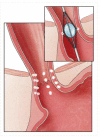A Review of New Surgical and Endoscopic Therapies for Gastroesophageal Reflux Disease
- PMID: 27489524
- PMCID: PMC4969778
A Review of New Surgical and Endoscopic Therapies for Gastroesophageal Reflux Disease
Abstract
Treatment of gastroesophageal reflux disease in the United States today is binary, with the majority of patients with gastroesophageal reflux disease being treated with antisecre-tory medications and a minority of patients, typically those with volume regurgitation, undergoing Nissen fundoplication. However, there has been increasing dissatisfaction with proton pump inhibitor therapy among a significant number of patients with gastroesophageal reflux disease owing to cost, side effects, and refractory symptoms, and there has been a general reluctance to undergo surgical fundoplication due to its attendant side-effect profile. As a result, a therapy gap exists for many patients with gastroesophageal reflux disease. Alternative techniques are available for these gap patients, including 2 endoscopic fundoplication techniques, an endoscopic radiofrequency energy delivery technique, and 2 minimally invasive surgical procedures. These alternative techniques have been extensively evaluated; however, there are limitations to published studies, including arbitrary definitions of success, variable efficacy measurements, deficient reporting tools, inconsistent study designs, inconsistent lengths of follow-up postintervention, and lack of comparison data across techniques. Although all of the techniques appear to be safe, the endoscopic techniques lack demonstrable reflux control and show variable symptom improvement and variable decreases in proton pump inhibitor use. The surgical techniques are more robust, with evidence for adequate reflux control, symptom improvement, and decreased proton pump inhibitor use; however, these techniques are more difficult to perform and are more intrusive. Additionally, these alternative techniques have only been studied in patients with relatively normal anatomy. The field of gastroesophageal reflux disease treatment is in need of consistent definitions of efficacy, standardized study design and outcome measurements, and improved reporting tools before the role of these techniques can be fully ascertained.
Keywords: Gastroesophageal reflux disease; Nissen fundoplication; proton pump inhibitor.
Figures



References
-
- Shaheen NJ, Hansen RA, Morgan DR, et al. The burden of gastrointestinal and liver diseases, 2006. Am J Gastroenterol. 2006;101(9):2128–2138. - PubMed
-
- Becher A, El-Serag H. Systematic review: the association between symptomatic response to proton pump inhibitors and health-related quality of life in patients with gastro-oesophageal reflux disease. Aliment Pharmacol Ther. 2011;34(6):618–627. - PubMed
-
- Lagergren J, Bergström R, Lindgren A, Nyrén O. Symptomatic gastroesophageal reflux as a risk factor for esophageal adenocarcinoma. N Engl J Med. 1999;340(11):825–831. - PubMed
-
- Kahrilas PJ, Jonsson A, Denison H, Wernersson B, Hughes N, Howden CW. Regurgitation is less responsive to acid suppression than heartburn in patients with gastroesophageal reflux disease. Clin Gastroenterol Hepatol. 2012;10(6):612–619. - PubMed
-
- Blonski W, Vela MF, Castell DO. Comparison of reflux frequency during prolonged multichannel intraluminal impedance and pH monitoring on and off acid suppression therapy. J Clin Gastroenterol. 2009;43(9):816–820. - PubMed
LinkOut - more resources
Full Text Sources
Research Materials
Miscellaneous
